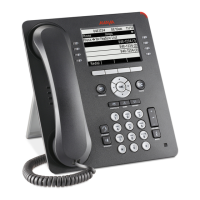Network requirements
24 Administering Avaya 9601/9608/9608G/9611G/9621G/9641G IP Deskphones SIP
Comments? infodev@avaya.com
● Avaya Aura
®
Conferencing
● Branch Session Manager for Geo redundancy
While the servers listed provide different functions that relate to the 9600 Series IP deskphones,
they are not necessarily different boxes. For example, DHCP provides network information
whereas HTTP provides configuration and application file management, yet both functions can
co-exist on one hardware unit.
For parameters related to Avaya Communication Manager information, see Chapter
4: Configuring Avaya Aura® for Avaya Deskphone SIP. For parameters related to DHCP and
file servers, see
Chapter 5: Administering DHCP and HTTP servers.
!
Important:
Important: The deskphones obtain important information from the upgrade files on the
servers and depend on the application file for software upgrades. If these servers
are unavailable when the deskphones reset, the deskphones will not operate
properly. Some features might not be available. To restore them you need to
reset the deskphones when the file server is available.
DHCP server
Install the DHCP server and application as described in Administering the DHCP and File
Servers on page 43.
HTTP/HTTPS server
Administer the HTTP or HTTPS file server as described in HTTP Generic Setup on page 51.
Network Time Protocol (NTP) server
SIP IP Deskphones require NTP server support to set the time and date, used in system log
time stamps and other time/date functions. The NTP server is typically needed by one or more
servers within the enterprise. Administration of the NTP server is beyond the scope of this
document.
Presence services
The deskphone retrieves presence information of contacts from Avaya Aura
®
Presence
Services. To enable presence, the parameter ENABLE_PRESENCE must be set to 1 in the
settings file.

